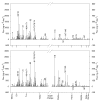Fate of PCB congeners in an industrial harbor of Lake Michigan
- PMID: 20131898
- PMCID: PMC3257175
- DOI: 10.1021/es902911a
Fate of PCB congeners in an industrial harbor of Lake Michigan
Abstract
We have quantified the release of polychlorinated biphenyls (PCBs) from Indiana Harbor and Ship Canal (IHSC) to Lake Michigan and the atmosphere. Navigational dredging is planned for this system, and there is concern that dredging will result in releases of PCBs. We have analyzed greater than 158 PCBs in surficial sediment, water, suspended particles, and air. We predicted the release of PCBs from sediments to water and from water to air. To quantify the level of confidence in our calculations, we used a Monte Carlo simulation for each congener flux. We determined that 4 +/- 0.05 kg of summation operatorPCBs were released from the sediment to the water and 7 +/- 0.1 kg of summation operatorPCBs were volatilized from the water to the air annually. We measured input from the upstream regions of the canal system of 45.0 kg yr(-1) and export to Lake Michigan of 43.9 kg yr(-1). The summation operatorPCBs mass balance accounts for nearly all the PCB inputs and losses to the navigational regions. The congener profiles in sediment, water, and air support our determination that the contaminated sediment is a major source of PCBs into the water and air above it. We have shown that the system is currently a significant source of PCBs to the air and to Lake Michigan, even under quiescent conditions.
Figures





Similar articles
-
Discovery of hydroxylated polychlorinated biphenyls (OH-PCBs) in sediment from a lake Michigan waterway and original commercial aroclors.Environ Sci Technol. 2013 Aug 6;47(15):8204-10. doi: 10.1021/es402323c. Epub 2013 Jul 26. Environ Sci Technol. 2013. PMID: 23862721 Free PMC article.
-
Updated Polychlorinated Biphenyl Mass Budget for Lake Michigan.Environ Sci Technol. 2017 Nov 7;51(21):12455-12465. doi: 10.1021/acs.est.7b02904. Epub 2017 Oct 17. Environ Sci Technol. 2017. PMID: 29039188
-
Polychlorinated biphenyls in the surficial sediment of Indiana Harbor and Ship Canal, Lake Michigan.Environ Int. 2010 Nov;36(8):849-54. doi: 10.1016/j.envint.2009.01.015. Epub 2009 Mar 5. Environ Int. 2010. PMID: 19268364 Free PMC article.
-
Polychlorinated biphenyls (PCBs) in San Francisco Bay.Environ Res. 2007 Sep;105(1):67-86. doi: 10.1016/j.envres.2007.01.013. Epub 2007 Apr 23. Environ Res. 2007. PMID: 17451673 Review.
-
Environmental fate and global distribution of polychlorinated biphenyls.Rev Environ Contam Toxicol. 2009;201:137-58. doi: 10.1007/978-1-4419-0032-6_5. Rev Environ Contam Toxicol. 2009. PMID: 19484591 Review.
Cited by
-
Aerobic Bioaugmentation to Decrease Polychlorinated Biphenyl (PCB) Emissions from Contaminated Sediments to Air.Environ Sci Technol. 2022 Oct 18;56(20):14338-14349. doi: 10.1021/acs.est.2c01043. Epub 2022 Sep 30. Environ Sci Technol. 2022. PMID: 36178372 Free PMC article.
-
Discovery of hydroxylated polychlorinated biphenyls (OH-PCBs) in sediment from a lake Michigan waterway and original commercial aroclors.Environ Sci Technol. 2013 Aug 6;47(15):8204-10. doi: 10.1021/es402323c. Epub 2013 Jul 26. Environ Sci Technol. 2013. PMID: 23862721 Free PMC article.
-
Sediment pore water distribution coefficients of PCB congeners in enriched black carbon sediment.Environ Pollut. 2013 Nov;182:357-63. doi: 10.1016/j.envpol.2013.07.015. Epub 2013 Aug 23. Environ Pollut. 2013. PMID: 23974165 Free PMC article.
-
Air-water PCB fluxes from southwestern Lake Michigan revisited.Environ Sci Pollut Res Int. 2020 Mar;27(9):8826-8834. doi: 10.1007/s11356-019-05159-1. Epub 2019 May 7. Environ Sci Pollut Res Int. 2020. PMID: 31062242 Free PMC article.
-
A comprehensive approach to actual polychlorinated biphenyls environmental contamination.Environ Sci Pollut Res Int. 2016 May;23(9):8770-80. doi: 10.1007/s11356-016-6108-4. Epub 2016 Jan 25. Environ Sci Pollut Res Int. 2016. PMID: 26805927
References
-
- International Joint Commission. Status of Restoration Activities in Great Lakes Areas of Concern: A Special Report. Final. 2003.
-
- USEPA. Results of the Lake Michigan Mass Balance Project: Polychlorinated Biphenyls Modeling Report. 2006.
-
- USEPA. Results of the Lake Michigan Mass Balance Project; Polychlorinated Biphenyls and trans-Nonchlor Data Report. 2004.
-
- Miller S. The effects of large-scale episodic sediment resuspension on persistent organic pollutants in southern Lake Michigan. The University of Iowa; Iowa City: 2003.
-
- Yang D, Kim KH, Phimister A, Bachstetter AD, Ward TR, Stackman RW, Mervis RF, Wisniewski AB, Klein SL, Kodavanti PRS, Anderson KA, Wayman G, Pessah IN, Lein PJ. Developmental Exposure to Polychlorinated Biphenyls Interferes with Experience-Dependent Dendritic Plasticity and Ryanodine Receptor Expression in Weanling Rats. Environ Health Persp. 2009;117(3):426–435. - PMC - PubMed
Publication types
MeSH terms
Substances
Grants and funding
LinkOut - more resources
Full Text Sources
Molecular Biology Databases

